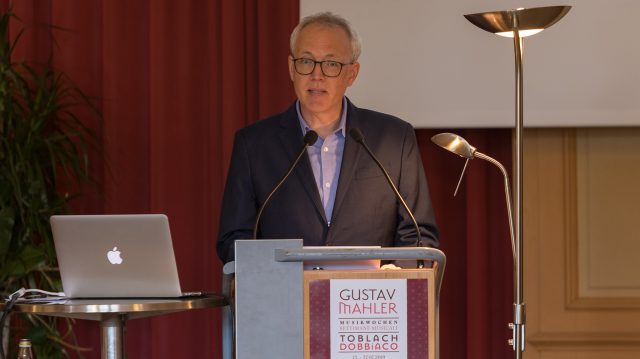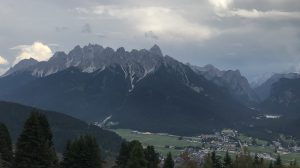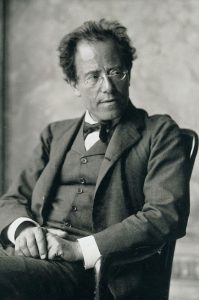
UM music professor Thomas Peattie presents at the 2019 Gustav Mahler Music Weeks, an annual festival in the town of Dobbiaco, Italy, that features a mixture of concerts and scholarly events. Photo courtesy Max Verdoes
OXFORD, Miss. – A longtime fascination with composer Gustav Mahler was rewarded recently when University of Mississippi music professor Thomas Peattie was among 10 scholars from seven countries invited to serve on the board of the new Gustav Mahler Research Center in Dobbiaco (known as Toblach in German), Italy.
The center – established by the University of Innsbruck in cooperation with the Foundation EUREGIO Kulturzentrum Gustav Mahler Toblach-Dolomiten – is a forum for discussion and the exchange of ideas among the international scholarly community researching the Austrian composer’s music.
“Mahler continues to be a particularly vibrant area of research,” said Peattie, the only scholar appointed from North America. “I feel very fortunate to have been invited to be part of this exciting new center.”
The composer is an interesting figure to both scholars and general audiences, in part because he bridges the 19th and 20th centuries, said Peattie, an associate professor of music at Ole Miss.
Rooted firmly in the tradition of Austro-German Romanticism that included Beethoven, Schubert, Liszt, Wagner and Brahms, Mahler also explored ideas that paved the way for modernism, influencing composers well into the 20th century and beyond. Much of Mahler’s impact can be felt in the ways he changed and reinvigorated the genre of the symphony, Peattie said.
“He once told Finnish composer Jean Sibelius that ‘a symphony must be like the world. It must embrace everything.'”
To widen the embrace of his symphonies, Mahler drew on a range of musical sources – from Austrian folk tunes to sacred music to his own lieder – and incorporated elements from the sonic landscape of the world he knew. Instruments utilized in nontraditional ways combine with sounds and noises – cowbells and church bells, birdsong, a cuckoo’s call, a nightingale, military fanfares, even a giant hammer – to conjure Mahler’s surroundings.
“Mahler is noted for his relationship to landscape,” Peattie said. “His music reflects and refracts his environment.”
Mahler’s symphonies also contain a world of experience and emotion, moving from triumphant soaring melodies and rich harmonies to quiet, fading passages of self-doubt and despair.
All these musical and emotional elements “tell us about the world he inhabited, the landscape around him, what he heard and saw; taken together, all of this informs his massive symphonic structures,” Peattie said.
Peattie’s scholarly work on Mahler includes his first book, “Gustav Mahler’s Symphonic Landscapes” (Cambridge University Press, 2015). More recently, he has written on Mahler and the idea of listening as a creative practice.
“I’m interested in the notion of Mahler as an attentive listener who attended the world around him with a hyper-aware and generous ear that took everything in and reflected it back onto his enormous symphonic canvas,” he said.
Despite Mahler’s work being banned by the Nazis as “degenerate,” leading to a period of comparative neglect in Europe that lasted until the 1950s, it continued to have an impact on composers in both Europe and America.
Mahler had an important influence on the work of American composers Aaron Copland, Leonard Bernstein and Samuel Barber, Russia’s Dmitri Shostakovich, England’s Benjamin Britten and Italy’s Luciano Berio. In fact, Peattie’s research concentrates on Berio, including the deep connections to Mahler that can be found in his work.
“I’m interested in Berio’s relationship with the 19th century and, in particular, his transcriptions of Mahler and other composers,” Peattie said.
Mahler wrote his last works near the Austrian mountain resort of Toblach – since 1918, part of Italy – which led to the establishment there of the Gustav Mahler Research Center. “It is magnificent here, and surely will restore body and soul,” Mahler wrote to a friend.

The town of Dobbiaco, Italy, near where Mahler wrote his last works, is home of the the new Gustav Mahler Research Center. Photo by Thomas Peattie
The center is a place where scholars working on Mahler’s music can come together, “thinking, working, even writing together” to better understand the work and reach of this fascinating composer whose impact continues to echo, Peattie said
After experiencing a resurgence in popularity in the 1950s, Mahler’s work has enjoyed a long sustained period of affection from audiences around the world – and from the musicians and scholars who delve more deeply into his music.
“Mahler is still a major figure on concert programs around the world – most of the world’s orchestras play one of his symphonies every season, and it’s not uncommon to hear his music in films,” Peattie said.
Mahler made his living as a conductor and composed in his spare time, retreating to specially built composing huts that allowed him to work in isolation. He never composed an opera, despite a long career as conductor for opera houses in Austria, Czechoslovakia, Hungary, Germany and the U.S.
“Symphonies and songs are the two poles of his compositional output,” Peattie said, noting that Mahler often reused material from his songs in his symphonies. He reworked his tone poem, “Todtenfeier (Funereal Rites),” for example, into the first movement of his Symphony No. 2, which was performed by the LOU Symphony Orchestra in the fall of 2016.
“Dr. Peattie made an excellent presentation of the work for our audience at that concert,” recalled Selim Giray, LOU Symphony director, who called Peattie’s appointment to the center “a great honor.”
“Mahler is a very interesting composer both for musicians and audiences alike, and his music remains exhilarating,” said Giray, noting that the New York Philharmonic staged a two-week virtual celebration of Mahler during the second half of April.
Peattie recommends that anyone interested in learning more about Mahler visit the New York Philharmonic’s online festival – “Mahler’s New York: A Digital Festival” – or explore the website of the Gustav Mahler Music Weeks, which is an annual festival of Mahler’s work that is associated with the Mahler Research Center.
